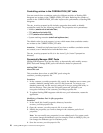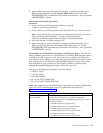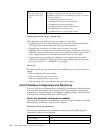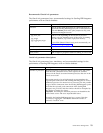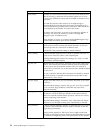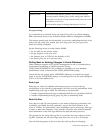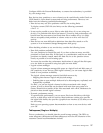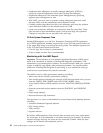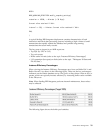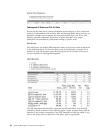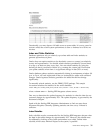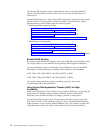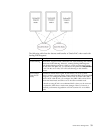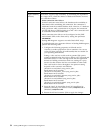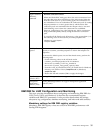v Implement these tablespaces as locally managed tablespaces (LMTs) by
specifying extent management as local when creating the tablespace.
v Implement tablespaces with Automatic Space Management by specifying
segment space management as auto.
v With LMTs, you may want to consider creating tablespaces that store small
reference tables with the autoallocate extent allocation model.
v Consider putting large tables into their own tablespace and using the uniform
extent allocation model. Use the default extent size 1 MB.
v Create your temporary tablespace as a temporary data file (temp files). Temp
files are used to store intermediate results, such as from large sort operation.
Changes to temp files are not recorded in the redo logs.
I/O Sub-System Response Time
Sterling B2B Integrator is an On-Line Transaction Processing (OLTP) application.
As an OLTP application, database response time to the I/O sub-system needs to be
in the single digit range even during the peak periods. The database response time
to the I/O sub-system should be less than:
v 5 ms for logs. 1ms or better is recommended.
v 10 ms or better for data. 5ms is recommended.
Monitoring with the AWR Report
Important: The information in an Automatic Workload Repository (AWR) report
needs to be considered in relation to Sterling B2B Integrator performance. This
information is not meaningful in isolation. You should monitor AWR over a period
of time to establish your steady state performance baseline. You should monitor
AWR even if Sterling B2B Integrator is performing to your satisfaction; doing so
could uncover issues before they become noticeable.
The AWR is used to collect performance statistics, including:
v Wait events used to identify performance problems
v Time model statistics indicating the amount of DB time associated with a process
from the V$SESS_TIME_MODEL and V$SYS_TIME_MODEL views
v Active Session History (ASH) statistics from the V$ACTIVE_SESSION_HISTORY
view
v Selected system and session statistics from the V$SYSSTAT and V$SESSTAT
views
v Object usage statistics
v Resource-intensive SQL statements
The repository is a source of information for several other Oracle database features,
including:
v Automatic Database Diagnostic Monitor
v SQL Tuning Advisor
v Undo Advisor
v Segment Advisor
By default, AWR snapshots of the relevant data are taken every hour and retained
for seven days. It is recommended to set shorter intervals, for example, 30 minutes,
because at longer intervals, the issues are less noticeable. Default values for these
settings can be altered with statements such as:
28 Sterling B2B Integrator: Performance Management



